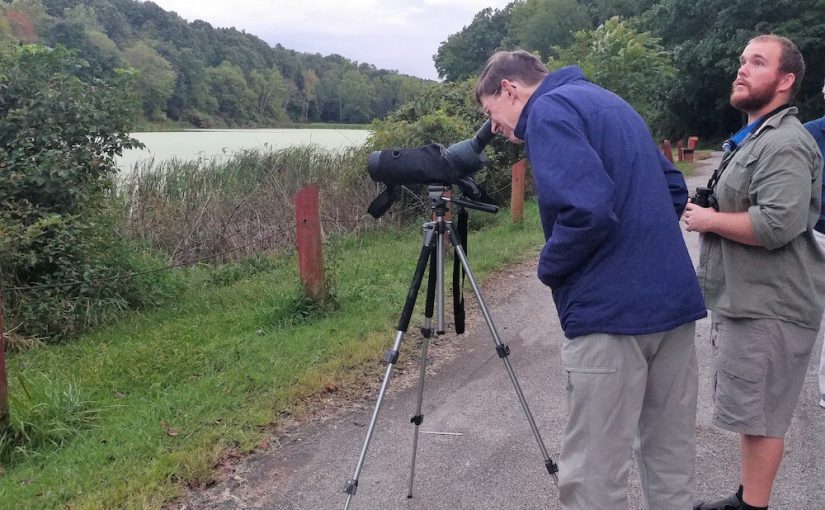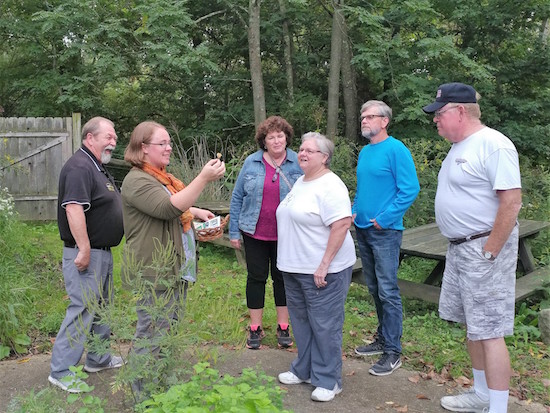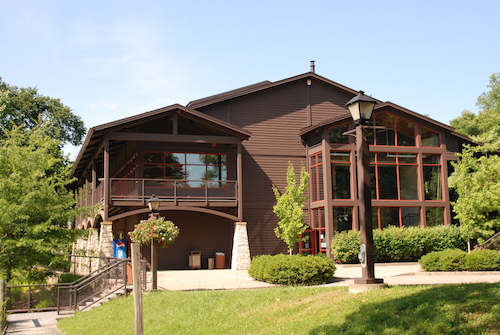by Laura Jackson Roberts
If you stand outside at night and hold a flashlight against your nose with the beam pointing down at the grass, you’ll see green flashes here and there. The illumination will remind you, somehow, of your cat’s eyes in the dark, hollow and vacant and other-worldly. These green lights are indeed eyes staring back at you: spider eyes. If you’re completely creeped out, you can skip this paragraph. But if you do see the little green lights, follow them. Inspect their source and you’ll find a spider. Yes, some will be big, but rest assured that most will be tiny.
Take a Hike: Full Moon Walk at Bear Rock Lakes
I learned this trick from Mike Hensley, a naturalist at Oglebay Institute’s Schrader Environmental Education Center. The Schrader Center has recently expanded their class offerings to include more adult nature programs. One evening in September, I met up with Mike and several other folks under a full moon at Bear Rock Lakes, beyond Dallas Pike.
In the past, I’ve attended family nature classes and events specifically for kids and toddlers. This time, though, I ditched the rugrats, and in so doing, I got to enjoy aspects of a full moon nature walk I normally miss when I’m mitigating fisticuffs and tying shoes. In fact, when I pulled up, I found Mike and the others gazing through a spotting scope at a flock of green-winged teals in the headwaters of the lake. North America’s smallest dabbling duck (a duck that floats and turns bum-up in the air, as opposed to a duck that dives completely underwater) probably wouldn’t have held my kids’ interest, but I was thrilled to get a chance to study them.
Mike explained that we’d be taking a guided hike through the woods, listening for animals, calling birds, and conducting a few sensory experiments. To my joy, the goal was quiet and peaceful nature.
Owls, Bats, Frogs and Fireflies!
We began with owl-calling in the forest, specifically screech and barred owls. Some nights Mike has been successful enough that an owl swooped in, but this evening they were stubborn and silent. Instead we heard a soothing chorus of katydids and crickets—not bad at all—and I asked Mike to identify each nighttime noise as I heard it.
As we walked along, Mike talked with us about using our sense of touch, the importance of which he demonstrated by having us reach into a bag to identify various seeds and leaves. From there we moved on to identifying frogs; despite the late season we heard a spring peeper and saw a few froggy eyes in the pond staring back at us. A little brown bat fluttered by, which sparked a bat lesson, and once we were all looking up, the conversation moved to stars and visible planets. Mike assembled the spotting scope again so we could view them. As we waited for the moon to rise, I found a glow-worm, the larval stage of a firefly. Mike identified the call of an American toad.
Everyone Needs a Naturalist
It was an evening during which we studied a little of everything we encountered and I thought to myself that everyone should have a naturalist on stand-by at all times. They’re very useful people.
A walk in the woods with a naturalist is a lot like bringing a set of encyclopedias with you. Encyclopedias, however, can’t engender a sense of wonder about the place you call home, a setting that tends to feel rather bland and ordinary. And they can’t teach you how to find spider eyeballs in the dark.
I had a good time on the moon walk, so a few weeks later I attended a second adult class: Fungus Among Us. While I’m not a mushroom collector and have only in my late 30s embraced them on pizza, I do find their study—and the people who dig them up—endlessly entertaining. We’ve always got strange specimens popping up in the backyard, but mushroom identification is a tricky pastime. Molly Check, the director at the Schrader Center, led this particular class.
I talked with Molly about the new adult programs.
“Each of our adult nature programs is unique, but they all provide opportunities to learn more about the natural world,” she said. “At the Schrader Center, we hope to inspire lifelong learners, from acorn to oak. No matter what your age, we have programs for you to enjoy. Nature provides many lessons for adults, from re-learning how to be still in the forest and listen to birdsong, to noticing unique features of a particular animal you may see in your neighborhood. The Schrader Center staff are knowledgeable and enthusiastic educators, ready to teach adults about wild edible plants, migrating birds, mammals, insects, gardening, sustainable living, tree ID, and so much more.”
Fungus Among Us
We started with a little classroom time. I was pleased to recall quite a bit of high school biology, but what I didn’t know was how to identify a mushroom. Molly taught us about life cycles and about categories including shelf fungus (the ones you see on tree trunks), cup fungus (which look like tiny champagne glasses), and puffballs (everybody’s favorite). We talked about where and when to find them (it turns out that fall is prime mushroom season), and then someone brought out a bag of lovely orange specimens and we all gathered around to sniff them and guess at their species.
Mushroom Hunting
The world of fungus boasts over 87,000 identified species, 1,700 of which are in West Virginia, so identification often requires more than just a picture in a book. Real fungus folk rely on microscopes and spore prints to correctly pinpoint what they’re looking at. And it’s important to do so, Molly said, when the conversation turned to poisonings. (Mushroom deaths seem to horrify and fascinate us in equal parts.)
“Most mushroom are not edible,” she reminded us. Granted, most toxic mushrooms aren’t fatal, but an identification mistake can certainly make you violently ill.
With our newfound knowledge, we wandered out into the butterfly garden and down into the woods behind the Schrader Center. Just like Mike, Molly seemed to know something about everything—bird calls and seed pods and butterflies. We brought her a variety of fungi: mostly shelf fungus known as Turkey Tail, but also Crowded Parchment, some tiny cup fungi, and a blog of orange jelly that, apparently, can move on its own as an animal would. Alas, when I brought Molly a stick, she told me I’d only found dry rot. Still, I now have mushrooming skills.
Maybe I’ll put them to use on one of my own hikes.
Go, See & Do!
If you’d like to check out one of the Schrader Center’s adult programs, you’ve got some great choices. Upcoming adult programs include Fall Birding (10/21 & 11/18), Full Moon Walks (1/31 & 3/1), Predators in Your Backyard (11/14), Trivia Pursuit (1/10), and Skulls (2/7). The Living Green Lecture Series will feature local presenters speaking on a variety of environmental topics on the last Sunday of each month from 2-3pm beginning in January.
Find out more at www.oionline.com or by calling the Schrader Center at 304-242-6855. Check out the online class schedule and visit the online calendar of events.



